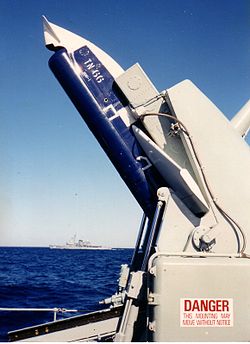This article includes a list of general references, but it lacks sufficient corresponding inline citations. (June 2008) |
| Ikara | |
|---|---|
 Ikara test missile on launcher[1] | |
| Type | Anti-submarine missile |
| Place of origin | Australia |
| Service history | |
| In service | 1960s–1990s |
| Used by | Royal Australian Navy Brazilian Navy Chilean Navy Royal New Zealand Navy Royal Navy |
| Production history | |
| Designed | Circa 1959–60 |
| Manufacturer | Australian Government Aircraft Factories/Commonwealth Aircraft Corporation (CAC)/Australian Defence Scientific Services (ADSS)[2] |
| Produced | Early 1960s |
| Variants | Two: Royal Australian Navy, Royal Navy |
| Specifications | |
| Mass | 513 kilograms (1,131 lb) |
| Length | 3.429 metres (135.0 in) |
| Wingspan | 1.524 metres (60.0 in) |
| Warhead | Mark 44 (two versions) Mark 46 NDB (Nuclear Depth Bomb). |
Detonation mechanism | none |
| Engine | Bristol Aerojet Murawa two-stage solid-fuel rocket engine.[3] |
Operational range | Maximum range: 10 nautical miles (19 km) Minimum (safety) range: 914 metres (1,000 yd) |
| Flight ceiling | 335 metres (1,099 ft) |
| Maximum speed | Boost max: 713 kilometres per hour (443 mph) Cruise: 658 kilometres per hour (409 mph) Maximum boost acceleration: 10.9G Boost burn time: 1.96 seconds Launcher maximum elevation: 55° Maximum range time interval: 100 sec. |
Guidance system | Command guidance |
Steering system | Elevons |
Launch platform | Ship-borne |
The Ikara missile was an Australian ship-launched anti-submarine missile, named after an Australian Aboriginal word for "throwing stick". It launched an acoustic torpedo to a range of 10 nautical miles (19 km), allowing fast-reaction attacks against submarines at ranges that would otherwise require the launching ship to close for attack, placing itself at risk. By flying to a distant target, the engagement time was dramatically shorter than provided by short-range weapons, giving the target less time to respond.
- ^ Note: Test missiles (explosively inert) were blue and warshots and practice (live) missiles were white.[citation needed]
- ^ "Chapter 13 – Defence Science and Technology". Technology in Australia 1788–1988. Australian Academy of Technological Sciences and Engineering. 1988. p. 921. ISBN 0-908029-49-7. Retrieved 2011-01-26.
{{cite book}}:|work=ignored (help) - ^ "Part of RecordSearch unavailable". Naa12.naa.gov.au. Retrieved 2011-01-26.[permanent dead link]